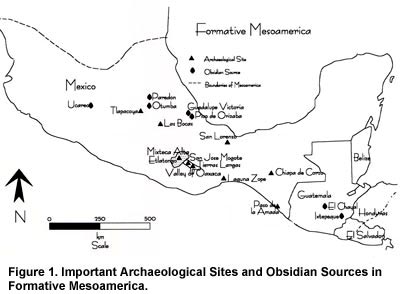
| FAMSI © 2004: Jeffrey P. Blomster |
||
|
Diachronic and Synchronic Analyses of Obsidian Procurement in the Mixteca Alta, Oaxaca Background: The Mixteca Alta and Etlatongo The Mixteca Alta lies in the southern highlands of Oaxaca, México (see Figure 1, above). Located at 2,000 meters above sea level, the Nochixtlán Valley is the largest valley in this mountainous region. The Mixteca Alta served as the crucible for the development of the rich and varied Mixtec culture, best known for the system of competitive city-states referred to as cacicazgos at the time of the Conquest. Early developments in Mixtec culture – particularly during the Formative period – remain poorly understood. Scholars often interpret this dearth of knowledge as a sign that the Mixtec Alta remained uninvolved in many of the cultural developments occurring across Mesoamerica. Indeed, scholars often contrast the Valley of Oaxaca and the Mixteca Alta, referring to the latter as "peripheral" to larger pan-Mesoamerican developments (Marcus 1989). In order to explore early social complexity and interregional interaction in the Nochixtlán Valley, I conducted fieldwork in 1992 at the site of Etlatongo, located north of the confluence of two rivers, approximately 10 km south of Yucuita. Previously known only from several test units (Zárate Morán 1987), I directed surveying, mapping, and much more intensive excavations at Etlatongo. I have argued that the results of the excavation indicate the Mixtecs’ role in Formative prehistory must undergo substantial revision (Blomster 1998, 2004). Analysis of obsidian provides one line of evidence on ancient interaction at Etlatongo. |
||
|
Text links to all pages at this site are available at the FAMSI INDEX |
||
